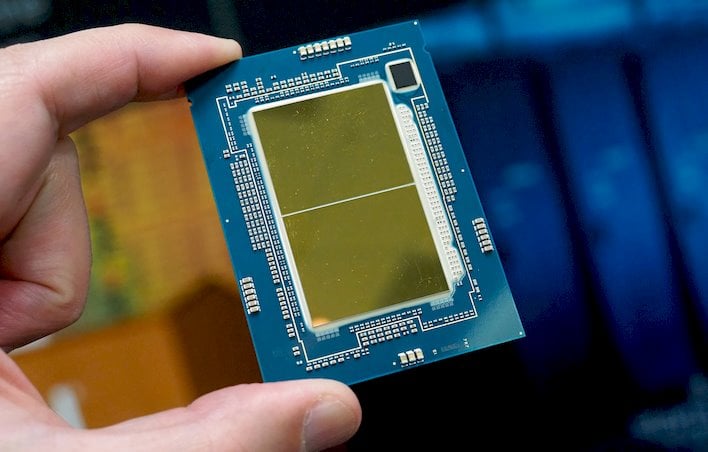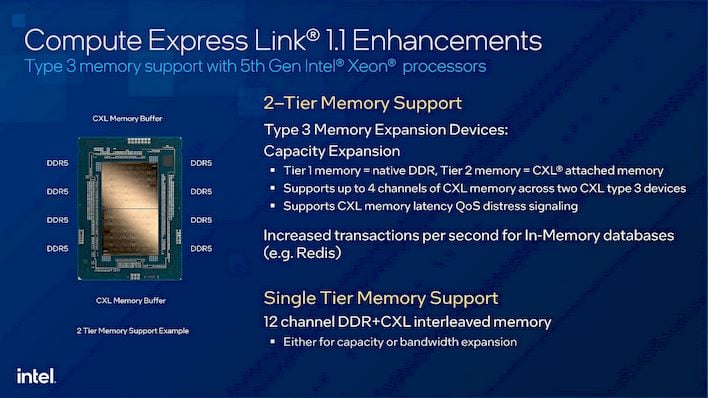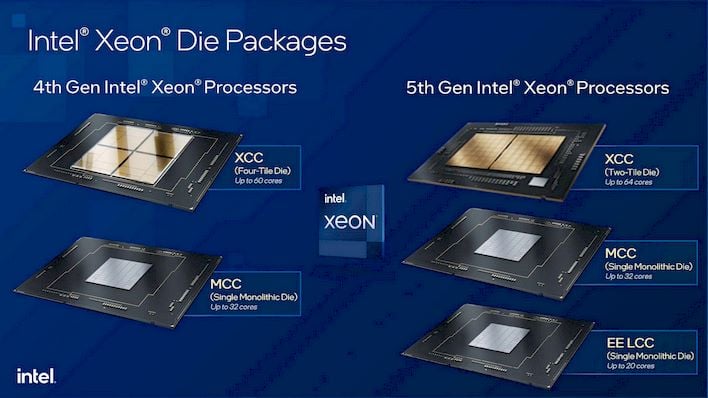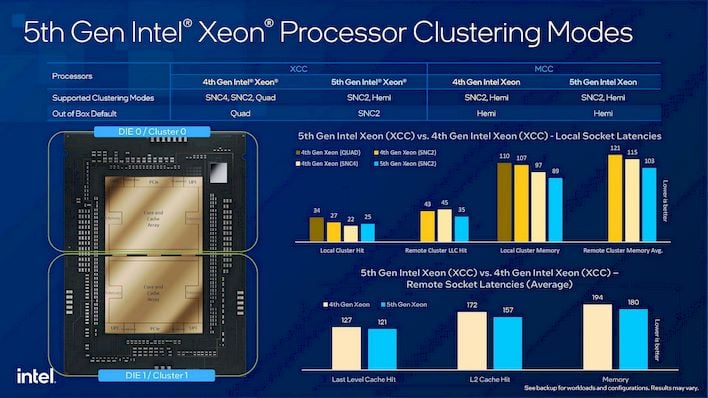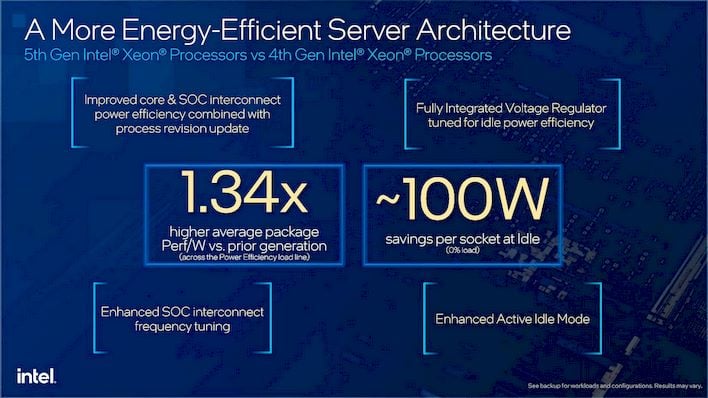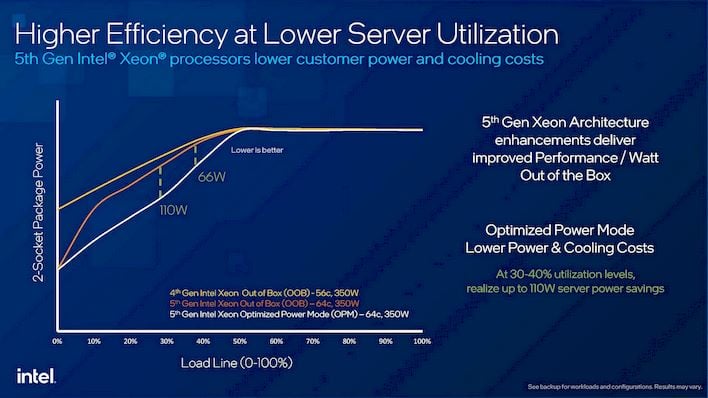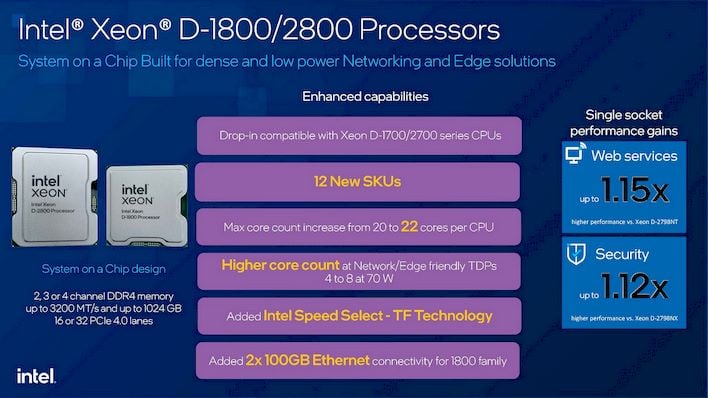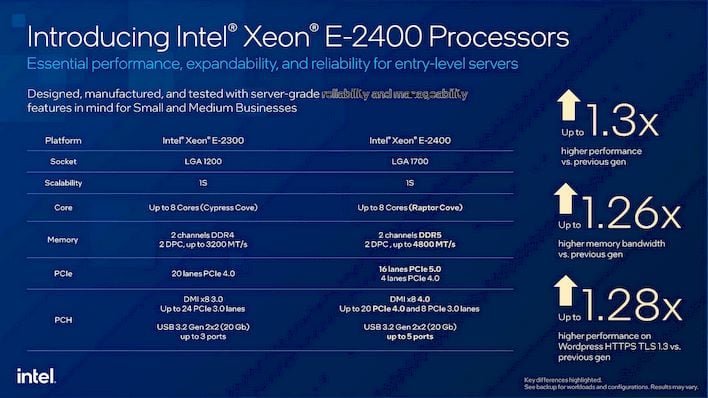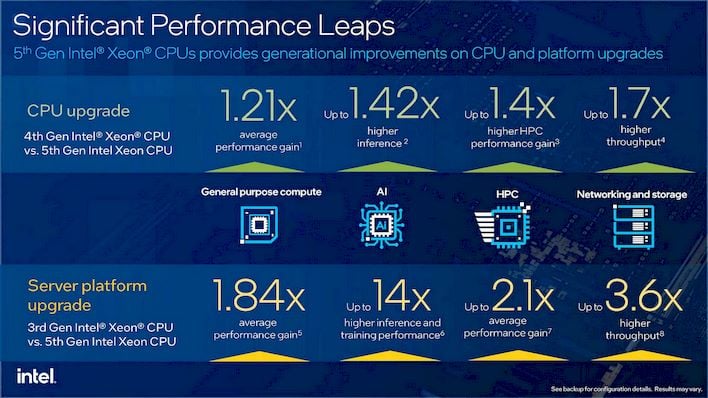Intel 5th Gen Xeon Processors Debut: Emerald Rapids Benchmarks
Intel 5th Gen Xeon Scalable: Emerald Rapids Tested In A Variety Of Data Center Workloads
| Intel 5th Generation Xeon Processors Codename: Emerald Rapids Intel refreshes its tiled chiplet based Xeon processors with more cores, more cache, higher frequencies, and enhanced power efficiency.
|
|||

|

 |
||
Intel held its ‘AI Everywhere’ event live from the Nasdaq in New York City recently, during which the company launched it 5th Gen Intel Xeon processors for data centers and Meteor Lake-based Intel Core Ultra processors for laptops and other small form factor applications. We were lucky enough to host a livestream the day before the event with a couple of Intel gurus to cover some of the finer details of the Intel Core Ultra series of processors, which we suggest checking out when you have some spare time. During that stream we got an exclusive first look at some Core Ultra benchmarks and we followed up with a full review of a Core Ultra-based laptop shortly thereafter.
Here we’ll be discussing the new Intel 5th Gen Intel Xeon processors, codenamed Emerald Rapids. 5th Gen Intel Xeon processors are an evolution of Sapphire Rapids, which we evaluated earlier in the year, that offer a myriad of refinements and improvements, to enhance both power efficiency and performance.
Introducing Emerald Rapids 5th Gen Xeon Processors
5th Gen Xeon Scalable processors feature the same core microarchitecture as their 4th Gen cousins based on Sapphire Rapids, they’re built using the same Intel 7 process, and they are drop-in compatible with the same socket and platforms as well. As such, virtually all of Intel's partners can quickly transition to 5th Gen Xeon Scalable processors in their server offerings. These new processors benefit from another year of refinements to Intel’s manufacturing process and incorporate a number of tweaks to firmware, packaging, and the design of the chips to boost both performance and efficiency.
Whereas 4th Gen Xeon processors topped out at a total of 60 cores, 5th Gen Xeon Scalable processors have up to 64 cores per CPU. These newer processors are also treated to a refined memory controller that’s compatible with DDR5 memory operating at up the 5600MT/s. What will perhaps be most interesting to IT decision makers contemplating new servers at the moment is Emerald Rapids’ upgraded cache configuration. At the top of the stack, some 5th Gen Xeon Scalable processor models, which feature dual 32-core XCC tiles, will feature about 3X more LLC (Last Level Cache), bringing the total to 320MB. Many data center workloads benefit greatly from large caches, close to the processor cores, so this upgrade alone may be significant for some of Intel’s customers. 5th Gen Xeon Scalable processors also feature UPI 2.0 links with speeds of up to 20GT/s, and they support Intel's Trust Domain Extension, hardware-based trusted execution environment.
Another update to 5th Gen Xeon Scalable processors is support for CXL type 3 memory over the Compute Express Link 1.1. CXL Type 3 devices can expand the host memory of a system over the CXL interface. Of course, 5th Gen Xeon Scalable processors also feature up to 12-channel native memory support as well (like 4th Gen Xeon processors). The combination of 12-channel DDR5 memory and CXL Type 3 attached devices, which can be used to expand capacity or increase bandwith, allows for massive memory pools and increased transaction speeds, for large in-memory databases and other big-data workloads, or virtual machine expansion.
Like 4th Gen Xeon processors based on Sapphire Rapids, 5th Gen Xeon processors feature multiple tile configurations. The top-end “XCC” processors feature two tile die (up to 32 cores each, 64 cores total). “MCC” 5th Gen Xeons use a single monolithic die for up to 32 cores (similar to 4th Gen). And “EE LCC” Xeons also use a single monolithic die with up to 20 cores.
The change from quad-tiles on Sapphire Rapids with XCC processors down to two larger tiles on Emerald Rapids is what enables the improvement in cache size and power efficiency. It also results in some latency improvements. When data crosses tiles, there’s a performance and latency impact, and performance variation, which is minimized on Emerald Rapids. Packaging of the largest processors is also somewhat simplified and required fewer EMIB interconnects.
The switch to dual tiles on XCC 5th Gen Xeon Scalable processors changes support for various clustering modes. Whereas 4th Gen Xeons supported SNC (Sub-NUMA Clustering) in SNC4, SNC2, and Quad modes, 5th Gen Xeon support SNC2, or Hemi (Hemisphere mode). The out of box default configurations are also different. MCC 5th Gen Xeons, which are based on a single tile, however, retain support for the same modes and defaults as 4th Gen Xeons.
The use of fewer EMIB interconnects along with some tuning to the interconnect frequencies, a bit of manufacturing maturity, and support for a new enhanced active idle mode results in significant energy efficiency improvements with 5th Gen Xeon processors versus 4th Gen parts. At idle, there can up to a 100W reduction in power consumption and there are additional improvements during periods of low server utilization.
A new optimized power mode available with 5th Gen Xeon processors can reduce power consumption by up to 110W per socket at utilization levels below 40%. 5th Gen Xeon processors have improved Turbo ratios for five different Turbo levels, which ultimately reduce the frequency penalty when using AVX512 or AMX instructions.
Reduced power consumption, in combination with increased Turbo frequencies, more cache, and support for faster memory results in big improvements in performance per watt for 5th Gen Xeon processors.
We should also quickly mention some updates to the Xeon D line-up. New Xeon D-1800 and Xeon D-2800 series processors remain drop-in compatible with existing platforms. There will be 12 new models, and the max core count increases to 22 cores per CPU. There will be higher core counts in the lower power parts destined for network/edge applications as well. 70w models move from 4 to 8 cores, nearly doubling the compute resources for those chips. The chips also gain support for Intel Speed Select Technology - Turbo Frequency (Intel SST-TF), which offers the ability to assign prioritization on turbo frequency to specific cores. The Xeon D-1800 family also gets support for dual 100Gb Ethernet connectivity.
Xeon E-2400 series processors also receive some updates. Xeon D-2400 processors will have up to 8 Raptor Cove cores, with a maximum frequency of over 5.5GHz. They also move to a new socket, and DDR5 memory, with support for speeds up to 4800MT/s. There are some changes to the PCIe lane configurations (PCIe 3 vs. PCIe 4), number of DMI links, and maximum number of USB 3.2 Gen 2.2 ports supported.
All of the changes to Emerald Rapids-based 5th Gen Xeon processors will result in increased performance or efficiency, or both depending on the workload. As such, the processors represent a significant upgrade for customers still utilizing older platforms.
Like 4th Gen Xeon Processors, 5th Gen Xeons also feature an array of accelerators to benefit particular workloads (when enabled), above and beyond what the CPU cores can offer on their own. The assortment of accelerators include:
- Intel Advanced Matrix Extensions (Intel AMX)
- Intel Data Streaming Accelerator (Intel DSA)
- Intel In-Memory Analytics Accelerator (Intel IAA)
- Intel Dynamic Load Balancer (Intel DLB)
- Intel Advanced Vector Extensions (Intel AVX) for vRAN
- Intel Advanced Vector Extensions 512 (Intel AVX-512)
- Intel QuickAssist Technology (Intel QAT)
- Intel Crypto Acceleration
As was the case with the 4th Gen silicon, Intel is offering its On Demand service to allow customers to expand the processor's accelerator capabilities as needed. Intel believes the flexible nature of On Demand adds value to its customers because they don’t have to incur additional costs for accelerators they may not use, and can add the functionality at a later time, as availability of software that leverage the accelerators becomes more pervasive. The flipside to that point is that customers will have powerful silicon in their systems lying dormant.
In total, Intel is releasing over 30 5th Gen Xeon SKUs, which is a significant reduction versus the previous gen. The available accelerators in a given model vary depending on the chip’s intended segment and where it falls within its stack, however. And with that, let's see how these new processors perform...
In total, Intel is releasing over 30 5th Gen Xeon SKUs, which is a significant reduction versus the previous gen. The available accelerators in a given model vary depending on the chip’s intended segment and where it falls within its stack, however. And with that, let's see how these new processors perform...

